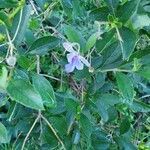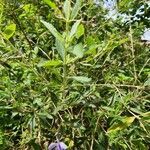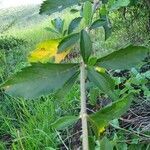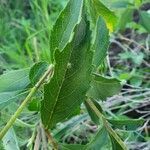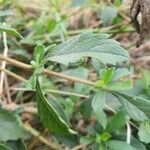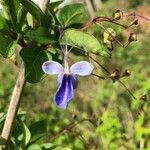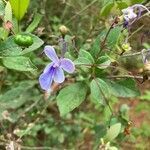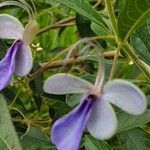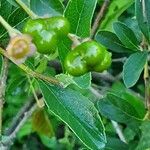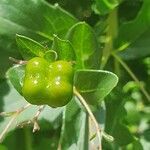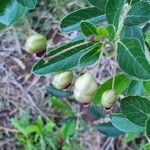An evergreen shrub or small tree. It grows 3-7 m tall. The bark is grey. It has marks along it. The bark on the older branches is rough and cracked. It has irregular branches. The leaves are opposite or in rings of 3-4 and oval. They are wedge shaped at the base and tapers to the tip. They are 2.5-9.5 cm long by 1-5.5 cm wide. They are softly textured. There are fine dense hairs on both surfaces. The underneath surface is paler. The edges have coarse teeth. The base of the leaf tapers running into the leaf stalk. The leaf stalk can be 1.5 cm long. The flowers are 2 cm across. They occur in heads of a few flowers in the axils of leaves and at the ends of branches. The fruit have 2-4 lobes. They are 5-10 mm across and reddish but turn black when mature. The fruit are edible.
Leaves opposite or in whorls of 3–4; lamina 2–16(19.5) × 0.4–6(10) cm, narrowly to broadly elliptic, ovate-elliptic or oblanceolate, oblong or obovate, usually small but in cultivation can attain large dimensions, acute to acuminate at the apex, cuneate to ± attenuate at the base, entire to coarsely serrate, glabrous or pubescent to densely velvety hairy, glandular-punctate beneath, ± sessile or petiole up to 15 mm long, with unpleasant smell when crushed.
Shrub, 0.9-2.0 m high. Leaves opposite or in whorls of 3 or 4, narrowly to broadly elliptic, ovate-elliptic or oblanceolate, entire to coarsely serrate. Cymes lax, long-pedunculate, terminal or clustered at ends of short leafy axillary branches. Flowers zygomorphic. Segments of lower lip of corolla longer than upper, corolla tube 12 mm long. Flowers greenish white or mauve.
Corolla asymmetrical in bud expanding abruptly on anterior side, usually greenish with a white to pale blue to lilac limb, the median lobe dark blue; tube 5–7 mm long, pubescent at the throat; lobes unequal, (0.6)1–1.9(2) cm × (1.5)3.5–7.5 mm, the upper obovate, the lower one spathulate and much larger than the other four.
Flowers in few–several-flowered dichasial cymes arranged in unelaborated and lax to quite extensive and elongate panicles 6.5–15(30) cm long; peduncles 0–7 cm long, secondary peduncles up to 4 cm long; apparent stalks 1–2.5 cm long but true pedicels 3–5 mm long.
Shrub up to 3 m tall, irregularly branched, or a small tree up to 10 m tall; older branches with rough deeply fissured bark; twigs pale brown, ridged or 4-angular, pithy in the centre, glabrous to velvety hairy.
Calyx often entirely purplish or crimson-margined, glabrous to hairy; tube cupular, c. 2.5 mm long; lobes semicircular to ovate or triangular, 1.2–5 mm long, quite rounded, obtuse or ± acute.
Shrub. Branches 4-angular. Branches and abaxial leaf surfaces velvety hairy. Leaves opposite, shortly petiolate, margins revolute. Calyx hairy, 4 mm long.
Fruit ± black, 5–6 × 8–10 mm, subglobose, depressed, mostly deeply 4-lobed, glabrous.
Stamens and style long-exserted and curving upwards.
